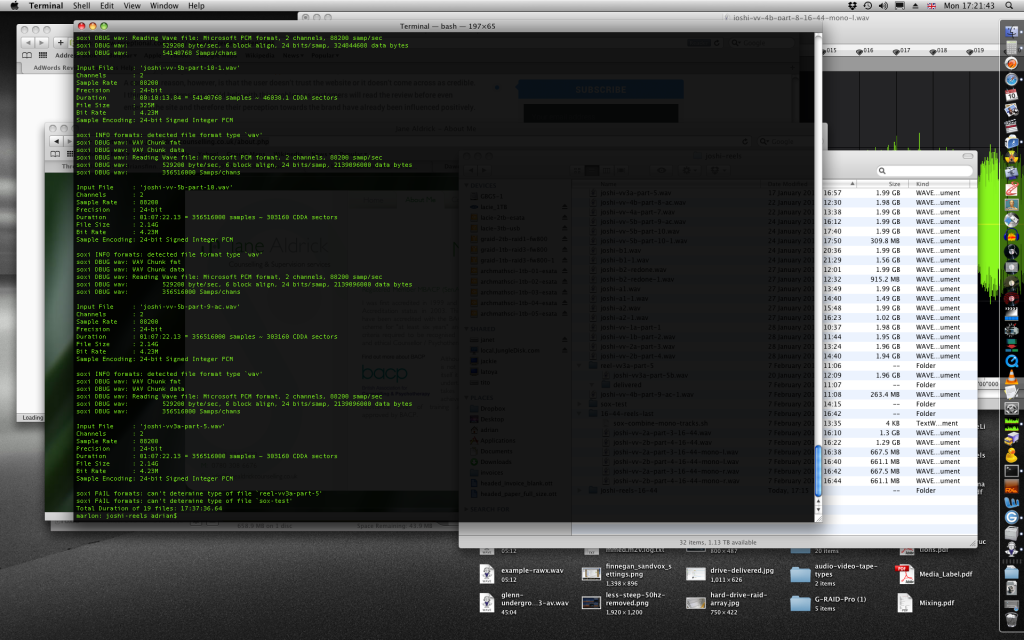In a technological world that is rapidly changing how can digital information remain accessible?
One answer to this question lies in the use of open source technologies. As a digital preservation strategy it makes little sense to use codecs owned by Mac or Windows to save data in the long term. Propriety software essentially operate like closed systems and risk compromising access to data in years to come.

It is vital, therefore, that the digitisation work we do at Great Bear is done within the wider context of digital preservation. This means making informed decisions about the hardware and software we use to migrate your tape-based media into digital formats. We use a mixture of propriety and open source software, simply because it makes our a bit life easier. Customers also ask us to deliver their files in propriety formats. For example, Apple pro res is a really popular codec that doesn’t take up a lot of data space so our customers often request this, and of course we are happy to provide it.
Using open systems definitely has benefits. The flexibility of Linux, for example, enables us to customise our digitisation system according to what we need to do. As with the rest of our work, we are keen to find ways to keep using old technologies if they work well, rather than simply throwing things away when shiny new devices come on the market. There is the misconception that to ingest vast amounts of audio data you need the latest hardware. All you need in fact is a big hard drive, flexible, yet reliable, software and an operating system that doesn’t crash so it can be left to ingest for 8 hours or more. Simple! Examples of open source software we use is the sound processing programme SoX. This saves us a lot of time because we are able to write scripts for the programme that can be used to batch process audio data according to project specifications.
Openness in the digital preservation world
Within the wider digital preservation world open source technologies are also used widely. From digital preservation tools developed by projects such as SCAPE and the Open Planets Foundation, there are plenty of software resources available for individuals and organisations who need to manage their digital assets. It would be naïve, however, to assume that the practice of openness here, and in other realms of the information economy, are born from the same techno-utopian impulse that propelled the open software movement from the 1970s onwards. The SCAPE website makes it clear that the development of open source information preservation tools are ‘the best approach given the substantial public investment made at the European and national levels, and because it is the most effective way to encourage commercial growth.’
What would make projects like SCAPE and Open Planets even better is if they thought about ways to engage non-specialist users who may be curious about digital preservation tools but have little experience of navigating complex software. The tools may well be open, but the knowledge of how to use them are not.
Openness, as a means of widening access to technical skills and knowledge, is the impulse behind the AV Artifact Atlas (AVAA), an initiative developed in conjunction with the community media archive project Bay Area Video Coalition. In a recent interview on the Library of Congress’ Digital Preservation Blog, Hannah Frost, Digital Library Services Manager at Stanford Libraries and Manager, Stanford Media Preservation Lab explains the idea behind the AVAA.
‘The problem is most archivists, curators and conservators involved in media reformatting are ill-equipped to detect artifacts, or further still to understand their cause and ensure a high quality job. They typically don’t have deep training or practical experience working with legacy media. After all, why should we? This knowledge is by and large the expertise of video and audio engineers and is increasingly rare as the analogue generation ages, retires and passes on. Over the years, engineers sometimes have used different words or imprecise language to describe the same thing, making the technical terminology even more intimidating or inaccessible to the uninitiated. We need a way capture and codify this information into something broadly useful. Preserving archival audiovisual media is a major challenge facing libraries, archives and museums today and it will challenge us for some time. We need all the legs up we can get.’
The promise of openness can be a fraught terrain. In some respects we are caught between a hyper-networked reality, where ideas, information and tools are shared openly at a lightning pace. There is the expectation that we can have whatever we want, when we want it, which is usually now. On the other side of openness are questions of ownership and regulation – who controls information, and to what ends?
Perhaps the emphasis placed on the value of information within this context will ultimately benefit digital archives, because there will be significant investment, as there already has been, in the development of open resources that will help to take care of digital information in the long term.